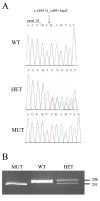A novel splice-site mutation of TULP1 underlies severe early-onset retinitis pigmentosa in a consanguineous Israeli Muslim Arab family
- PMID: 18432314
- PMCID: PMC2329669
A novel splice-site mutation of TULP1 underlies severe early-onset retinitis pigmentosa in a consanguineous Israeli Muslim Arab family
Abstract
Purpose: To investigate the genetic basis for autosomal recessive severe early-onset retinitis pigmentosa (RP) in a consanguineous Israeli Muslim Arab family.
Methods: Haplotype analysis for all known genes underlying autosomal recessive RP was performed. Mutation screening of the underlying gene was done by direct sequencing. An in vitro splicing assay was used to evaluate the effect of the identified mutation on splicing.
Results: Haplotype analysis indicated linkage to the Tubby-like protein 1 (TULP)1 gene. Direct sequencing revealed a homozygous single base insertion, c.1495+2_1495+3insT, located in the conserved donor splice-site of intron 14. This mutation co-segregated with the disease, and was not detected in 114 unrelated Israeli Muslim Arab controls. We used an in vitro splicing assay to demonstrate that this mutation leads to incorrect splicing.
Conclusions: To date, 22 distinct pathogenic mutations of TULP1 have been reported in patients with early-onset RP or Leber congenital amaurosis. Here we report a novel splice-site mutation of TULP1, c.1495+2_1495+3insT, underlying autosomal recessive early-onset RP in a consanguineous Israeli Muslim Arab family. This report expands the spectrum of pathogenic mutations of the TULP1 gene.
Figures




References
-
- Fazzi E, Signorini SG, Scelsa B, Bova SM, Lanzi G. Leber's congenital amaurosis: an update. Eur J Paediatr Neurol. 2003;7:13–22. - PubMed
-
- Hanein S, Perrault I, Gerber S, Tanguy G, Barbet F, Ducroq D, Calvas P, Dollfus H, Hamel C, Lopponen T, Munier F, Santos L, Shalev S, Zafeiriou D, Dufier JL, Munnich A, Rozet JM, Kaplan J. Leber congenital amaurosis: comprehensive survey of the genetic heterogeneity, refinement of the clinical definition, and genotype-phenotype correlations as a strategy for molecular diagnosis. Hum Mutat. 2004;23:306–17. - PubMed
-
- Koenekoop RK. An overview of Leber congenital amaurosis: a model to understand human retinal development. Surv Ophthalmol. 2004;49:379–98. - PubMed
-
- Hartong DT, Berson EL, Dryja TP. Retinitis pigmentosa. Lancet. 2006;368:1795–809. - PubMed
-
- Rivolta C, Sharon D, DeAngelis MM, Dryja TP. Retinitis pigmentosa and allied diseases: numerous diseases, genes, and inheritance patterns. Hum Mol Genet. 2002;11:1219–27. - PubMed
Publication types
MeSH terms
Substances
LinkOut - more resources
Full Text Sources
Research Materials
